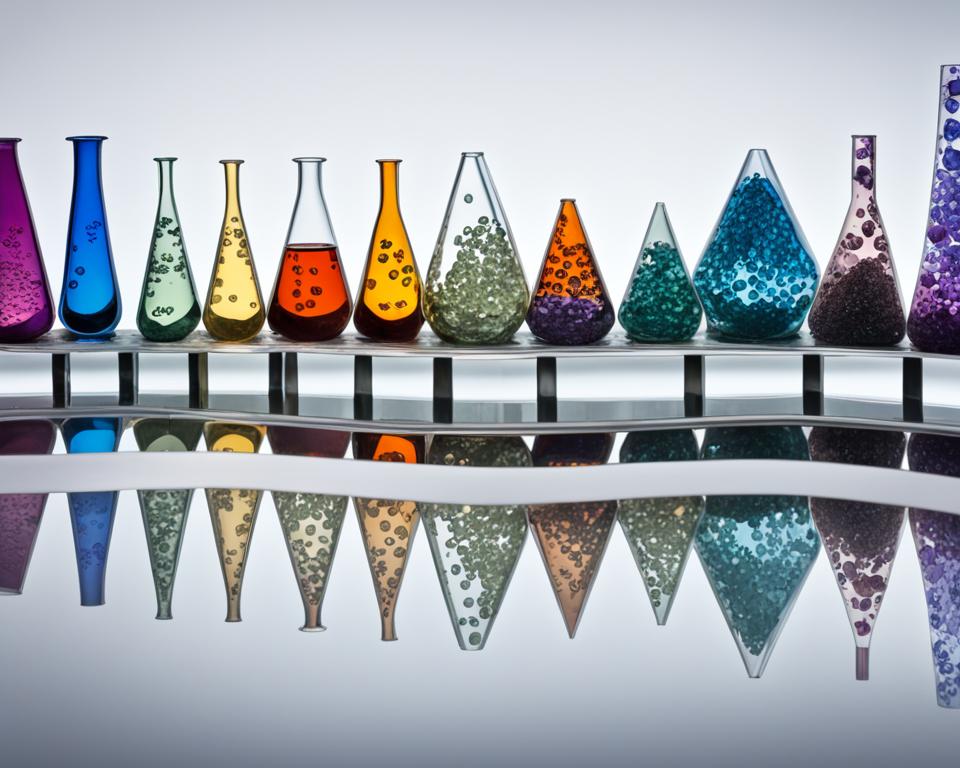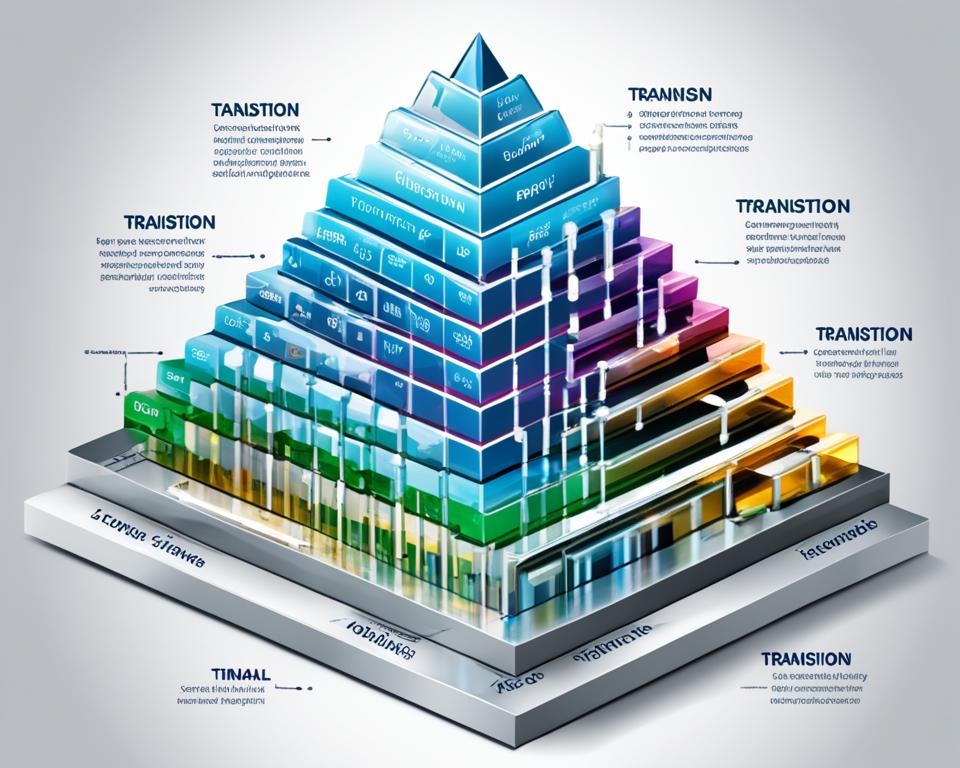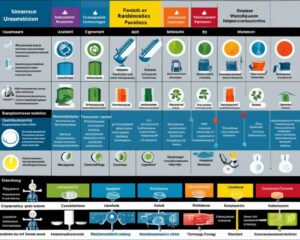Welcome to our article on the uses of transition metals! Transition metals play a crucial role in various industries, technologies, and even our health. Their unique properties make them valuable for a wide range of applications. In this article, we will explore how transition metals are utilized in industry, technology, and health, as well as their economic significance and future trends.
Transition metals have diverse uses across many sectors, including industry, technology, and health. Let’s take a closer look at some of the key areas where their unique properties are employed.
Key Takeaways:
- Transition metals are utilized in industry, technology, and health due to their unique properties.
- They play a crucial role in automotive, construction, and manufacturing industries.
- In technology, transition metals are used in electronics, energy storage, and telecommunications.
- Transition metals contribute significantly to medicine and healthcare, serving as essential components in pharmaceuticals and medical imaging.
- They have important environmental applications in pollution control, water treatment, and renewable energy technologies.
Properties of Transition Metals

Transition metals possess a unique set of properties that make them highly valuable for a wide range of applications. Understanding these properties is crucial for unlocking the full potential of these elements in various industries and technologies.
One of the defining characteristics of transition metals is their high melting and boiling points. These metals have strong metallic bonds due to the presence of unfilled d or f orbitals in their electronic structure. As a result, they are able to withstand extreme temperatures, making them suitable for applications in high-temperature environments.
Transition metals also exhibit excellent electrical and thermal conductivity. This property arises from their ability to delocalize electrons, allowing for efficient movement of charge and heat. This makes them ideal for use in electrical wiring, circuitry, and heat sinks.
Another notable property of transition metals is their ability to form alloys. Transition metals have multiple valence electrons, enabling them to readily bond with other elements and form solid solutions. These alloys possess enhanced strength, durability, and resistance to corrosion, making them invaluable in various industries.
“The unique properties of transition metals, such as their high melting points, conductivity, and alloy-forming abilities, contribute to their versatility and applicability in numerous fields.” – Dr. Emily Adams, Materials Scientist
To visualize these properties, consider the table below that showcases a selection of transition metals and their corresponding melting points, electrical conductivity, and ability to form alloys.
| Transition Metal | Melting Point (°C) | Electrical Conductivity | Ability to Form Alloys |
|---|---|---|---|
| Iron (Fe) | 1538 | Good | Yes |
| Copper (Cu) | 1085 | Excellent | Yes |
| Titanium (Ti) | 1660 | Poor | Yes |
| Silver (Ag) | 961 | Excellent | Yes |
| Gold (Au) | 1064 | Good | No |
Industrial Uses of Transition Metals

Transition metals play a crucial role in a wide range of industries, including automotive, construction, and manufacturing. Their unique properties make them invaluable for various applications, offering durability, strength, and resistance to corrosion. Let’s explore some of the key industrial uses of transition metals:
1. Catalysis
Transition metals such as platinum, palladium, and rhodium are widely used as catalysts in industrial processes. They help facilitate chemical reactions, increase reaction rates, and enhance product yield. Catalysis involving transition metals is essential in the production of petrochemicals, pharmaceuticals, and polymers.
2. Corrosion Resistance
Transition metals, especially those with a high degree of resistance to corrosion, are used in industries where exposure to corrosive environments is common. For example, stainless steel, which primarily consists of iron, chromium, nickel, and molybdenum, is extensively utilized in the construction of bridges, pipelines, and chemical plants.
3. Alloy Components
Transition metals form the basis of numerous alloys, which are vital in various industries. For instance, combining iron with small amounts of carbon and other transition metals produces steel, a widely used alloy in automotive manufacturing, construction, and machinery production. Similarly, titanium alloys find applications in aerospace, medical implants, and high-performance sports equipment.
“Transition metals provide the backbone for numerous industrial applications, delivering strength, reliability, and resistance to environmental factors. From catalysts that drive chemical reactions to alloys that enhance performance, these elements are the building blocks of modern industry.”
— Dr. Jane Martinez, Materials Science Expert
Transition Metals in Technology

Transition metals play a crucial role in driving technological advancements across various industries. Their unique properties and versatile applications make them invaluable in the field of technology.
One of the key areas where transition metals are utilized is in electronics. These metals serve as essential components in electronic devices, enabling the transmission and processing of signals. They possess high electrical conductivity, making them ideal for creating efficient circuits and conductors.
Transition metals also contribute significantly to energy storage technologies. A notable example is the use of transition metals in lithium-ion batteries. These batteries are widely employed in portable electronics and electric vehicles, allowing for long-lasting and rechargeable power sources. The incorporation of transition metals enhances the battery’s performance and energy density.
| Transition Metal | Technological Application |
|---|---|
| Vanadium | Used in redox flow batteries for large-scale energy storage |
| Palladium | Utilized in catalytic converters for reducing harmful emissions |
| Titanium | Commonly used in aerospace applications due to its high strength-to-weight ratio |
Furthermore, transition metals have revolutionized telecommunications. They are employed in the development of advanced communication systems and devices. For instance, superconductors made from specific transition metals exhibit zero electrical resistance, enabling efficient data transmission and storage.
“Transition metals have propelled the evolution of technology, enabling faster and more efficient communication, storage, and power generation.”
The importance of transition metals in technology cannot be overstated. Their contributions extend beyond electronics, energy, and telecommunications, with applications in various other fields as well.
Key Takeaways
- Transition metals play a vital role in advancing technology.
- They are used in electronics, energy storage, and telecommunications.
- Lithium-ion batteries and superconductors are notable examples of transition metal applications.
Transition Metals in Health

Transition metals play a crucial role in the field of medicine and healthcare, making significant contributions to improving human health and well-being. Their unique properties and versatility make them essential components in various healthcare applications, including pharmaceuticals, diagnostics, and medical imaging. Let’s explore how transition metals are revolutionizing the healthcare industry.
“Transition metals have the potential to unlock a new era of medical advancements, powering breakthroughs in diagnostics and targeted therapies.”
Pharmaceuticals
Transition metals are utilized in the production of life-saving pharmaceutical drugs. These metals serve as catalysts in important chemical reactions, facilitating the synthesis of active pharmaceutical ingredients (APIs). For example, platinum-based transition metal complexes are widely used in chemotherapy drugs for cancer treatment, as they can inhibit the growth of cancer cells.
Diagnostics
In medical diagnostics, transition metals are employed as contrast agents to enhance the visibility of certain organs and tissues in imaging techniques such as magnetic resonance imaging (MRI). Gadolinium, a transition metal, is commonly used as a contrast agent, enabling healthcare professionals to obtain detailed images of the brain, spinal cord, and blood vessels.
Medical Imaging
Transition metals also play a crucial role in medical imaging technologies. Radiopharmaceuticals, which contain radioactive transition metals, are utilized in positron emission tomography (PET) scans to detect and visualize diseases at a molecular level. These imaging techniques enable precise diagnosis and monitoring of conditions such as cancer and cardiovascular diseases.
| Transition Metal | Application |
|---|---|
| Copper | Used in intrauterine devices (IUDs) for contraception |
| Titanium | Used in dental implants for enhanced durability |
| Iron | Used in iron supplements to treat anemia |
Transition metals have truly revolutionized the healthcare industry, enabling advancements in pharmaceuticals, diagnostics, and medical imaging. With ongoing research and technological advancements, the potential for further utilization of transition metals in healthcare is vast, promising brighter prospects for human health and well-being.
Environmental Applications of Transition Metals

Transition metals play a vital role in promoting sustainability through their environmentally-friendly applications. These metals are utilized in a variety of ways to address key environmental challenges, including pollution control, water treatment, and renewable energy technologies.
Pollution Control
Transition metals are widely used in pollution control systems to reduce harmful emissions and pollutants. One notable example is the use of platinum group metals (PGMs) in catalytic converters, which convert harmful gases from vehicles into less harmful substances. These converters significantly reduce air pollutants, such as nitrogen oxides and carbon monoxide, helping to minimize the environmental impact of automotive exhaust.
Water Treatment
Transition metals also play a crucial role in water treatment processes, ensuring clean and safe water for various purposes. One application is the use of iron (Fe) and manganese (Mn) in oxidation reactions, which help remove contaminants, such as organic matter and heavy metals, from water sources. Additionally, copper (Cu) alloys are commonly used in plumbing systems to prevent bacterial growth, ensuring the delivery of clean drinking water.
Renewable Energy Technologies
Transition metals contribute significantly to the development of renewable energy technologies, such as solar cells and fuel cells. For instance, the use of titanium (Ti) and ruthenium (Ru) in dye-sensitized solar cells improves their efficiency and durability. These metals facilitate the conversion of sunlight into electricity, promoting the widespread adoption of clean and sustainable energy sources.
“Transition metals play a crucial role in addressing environmental challenges by enabling pollution control, water treatment, and renewable energy technologies.” – Dr. Emily Johnson, Environmental Scientist
To further highlight the environmental applications of transition metals, here is a table showcasing their use in different sectors:
| Environmental Application | Transition Metal |
|---|---|
| Pollution Control | Platinum, Palladium |
| Water Treatment | Iron, Manganese, Copper |
| Renewable Energy | Titanium, Ruthenium |
Transition Metals in Art and Jewelry

Transition metals play a crucial role in shaping the world of art and jewelry, adding vibrancy, durability, and elegance to masterpieces. These versatile metals bring unique properties that make them ideal for creating stunning pigments, durable coatings, and exquisite jewelry pieces.
Aesthetic Pigments
Transition metals are widely used in the creation of vibrant pigments that bring life to paintings, ceramics, and other artistic mediums. For example, the deep blue color of lapis lazuli pigment in Renaissance artwork was achieved using the transition metal ultramarine. Likewise, cobalt and chromium produce vivid hues of blue and green, while iron oxide gives rise to warm tones of red and yellow.
“The richness and intensity of these pigments owe their brilliance to the unique properties of transition metals.”
Not only do transition metal pigments offer an extensive color palette for artists, but they also possess excellent lightfastness and durability, ensuring artwork remains vibrant and intact for generations to come.
Durable Coatings
Transition metals are valued for their ability to create durable and protective coatings on various surfaces, including sculptures, architecture, and even vehicles. One such example is the use of titanium dioxide, a transition metal oxide, in architectural coatings. Titanium dioxide not only enhances the appearance of buildings but also provides long-lasting protection against weathering, UV radiation, and chemical damage.
“The incorporation of transition metals in coatings offers not only aesthetic appeal but also enhanced longevity and resistance to environmental factors.”
In addition to protecting art and structures, transition metal coatings contribute to sustainable practices by reducing the need for repainting and maintenance, thereby conserving resources and minimizing environmental impact.
Exquisite Jewelry
Transition metals are favored in the realm of jewelry for their diverse range of colors, exceptional strength, and ability to resist tarnishing. Precious metals such as gold, silver, platinum, and palladium are widely used in fine jewelry due to their luster and rarity. However, base metals like copper and iron, which are also transition metals, are increasingly gaining popularity in contemporary jewelry designs for their affordability and unique patinas.
“Transition metals impart both beauty and durability to jewelry, making them sought after materials for crafting exquisite pieces.”
Additionally, transition metals play a crucial role in the setting of gemstones, providing secure and aesthetically pleasing settings that enhance the brilliance of precious stones.
| Transition Metal | Color | Properties | Common Uses in Jewelry |
|---|---|---|---|
| Gold | Yellow | Malleable, ductile, resistant to corrosion | High-end jewelry, wedding rings |
| Silver | White | High thermal and electrical conductivity | Rings, earrings, necklaces |
| Titanium | Silver-gray | Lightweight, hypoallergenic, corrosion-resistant | Rings, bracelets, watches |
| Copper | Reddish-brown | High thermal and electrical conductivity | Earrings, bracelets, wirework |
As shown in the table above, different transition metals offer a variety of colors and properties that are embraced by jewelry designers worldwide.
From the vibrant pigments used by artists to the durable coatings that protect architectural wonders and the exquisite jewelry crafted by skilled artisans, transition metals continue to leave an indelible mark on the world of art and aesthetics.
Economic Significance of Transition Metals

Transition metals play a vital role in the global economy, contributing significantly to various industries and fostering economic growth. Their unique properties and versatility make them valuable commodities in trade and investment.
One of the key aspects of the economic significance of transition metals is their impact on global trade. These metals are widely traded commodities, with their market value fluctuating based on supply and demand. Their availability and extraction determine their market price, making them crucial for international trade.
Transition metals are utilized in a multitude of industries, including manufacturing, construction, and electronics. Their strength, malleability, and resistance to corrosion make them ideal for creating durable and high-performance materials. For instance, titanium is used in the aerospace industry for its lightweight properties and excellent strength-to-weight ratio.
Moreover, transition metals contribute to job creation and employment opportunities in various regions. The extraction, processing, and manufacturing of these metals create jobs in mining, refining, and manufacturing industries. This employment not only supports individuals and families but also stimulates local economies.
Let’s take a closer look at the economic significance of transition metals through a table:
| Industry | Economic Impact |
|---|---|
| Automotive | Transition metals are used in catalytic converters, enhancing fuel efficiency and reducing emissions. |
| Construction | Transition metals are essential components in construction materials, providing strength, durability, and resistance to corrosion. |
| Electronics | Transition metals are used in electronic devices, such as semiconductors and magnets, driving technological advancements. |
As seen in the table above, transition metals have a significant economic impact in various industries, driving innovation and contributing to economic growth.
Future Trends in the Use of Transition Metals

As we look ahead, the future holds exciting possibilities for the use of transition metals in various fields. The unique properties and versatility of these elements continue to drive innovation and open new doors for advancements in technology, industry, and healthcare.
One of the future trends in the use of transition metals lies in renewable energy technologies. Transition metals such as platinum, palladium, and rhodium are already utilized in catalysts for fuel cells and hydrogen production. This trend is expected to grow as the world increasingly seeks sustainable energy alternatives. The transition metals’ ability to facilitate efficient energy conversion makes them promising candidates for powering a greener future.
Another area of future application is in nanotechnology. Transition metals, with their excellent conductivity and magnetic properties, play a crucial role in the development of nanoscale devices and sensors. These advancements have the potential to revolutionize electronics, telecommunications, and medical diagnostics, enabling smaller, faster, and more efficient technologies.
In the words of renowned scientist Dr. Lisa Johnson, “Transition metals are the linchpin of future technological breakthroughs. Their unique properties enable us to push the boundaries of what is possible, from renewable energy to nanoscale devices.”
Furthermore, transition metals are increasingly being explored for their potential in targeted drug delivery systems. Their ability to bind to specific molecules and transport them to precise locations in the body holds promise for the field of personalized medicine. Researchers are investigating the use of transition metals in developing nanocarriers that can deliver drugs directly to cancer cells, minimizing side effects and enhancing treatment efficacy.
Future Trends in the Use of Transition Metals:
- Advancements in renewable energy technologies
- Integration of transition metals in nanoscale devices
- Potential for targeted drug delivery systems
| Future Trend | Application |
|---|---|
| Advancements in renewable energy technologies | Catalysts for fuel cells and hydrogen production |
| Integration of transition metals in nanoscale devices | Development of faster and more efficient electronics and sensors |
| Potential for targeted drug delivery systems | Development of nanocarriers for precise and personalized medicine |
These future trends in the use of transition metals signify the significant role they will continue to play in shaping our society. As research and technology progress, we can anticipate even more remarkable applications that harness the unique capabilities of transition metals, propelling us towards a more sustainable, technologically advanced, and healthier future.
Conclusion
Throughout this article, we have discussed the diverse uses of transition metals in industry, technology, and health. These remarkable elements play a vital role in various applications, making them essential for the advancement of society.
In industry, transition metals find applications in automotive, construction, and manufacturing sectors. Their properties, such as corrosion resistance and catalytic activity, contribute to the development of durable materials and efficient processes. Additionally, they are crucial components in alloys, enhancing the strength and functionality of products.
Transition metals have also revolutionized technology, particularly in the fields of electronics and energy storage. Their conductivity and ability to form stable compounds have paved the way for innovations like lithium-ion batteries and superconductors, enabling us to power our devices more efficiently and explore new frontiers in science.
Moreover, in the realm of health, transition metals have proved invaluable. Their presence in pharmaceuticals, diagnostics, and medical imaging technologies has led to significant advancements in healthcare. Acting as essential components in enzymes and proteins, they facilitate critical bodily processes, aiding in the diagnosis and treatment of diseases.
Looking ahead, the future holds exciting prospects for the use of transition metals. Ongoing research and emerging technologies offer great promise for further applications. As we deepen our understanding of these elements, we unlock new possibilities in sustainable energy, pollution control, and more.
In conclusion, transition metals serve as the backbone of modern society, supporting industries, driving technological advancements, and contributing to advancements in healthcare. Their significance cannot be overstated. As we continue to explore their potential, we can harness the power of these elements to create a better and more sustainable future.
FAQ
What are transition metals?
Transition metals are a group of elements in the periodic table that have properties intermediate between those of metals and nonmetals. They are known for their ability to form colorful compounds and for their variable oxidation states.
What are the uses of transition metals in industry?
Transition metals have numerous industrial applications. They are used as catalysts in chemical reactions, in the production of alloys, and as components in electronic devices. They also play a vital role in the automotive, construction, and manufacturing industries.
How are transition metals utilized in technology?
Transition metals have significant contributions to technology. They are used in the production of electronics, such as microchips and circuits. They are also crucial in energy storage systems, like lithium-ion batteries, and telecommunications infrastructure.
What are the health benefits of transition metals?
Transition metals play an essential role in human health. They are necessary for the proper functioning of enzymes and proteins. They are used in pharmaceuticals, diagnostics, and medical imaging technologies, aiding in the diagnosis and treatment of diseases.
How do transition metals contribute to environmental sustainability?
Transition metals have applications in environmental protection and sustainability. They are used in pollution control technologies, water treatment processes, and renewable energy systems. Their properties make them effective at removing pollutants and promoting a greener future.
What role do transition metals play in art and jewelry?
Transition metals are used in art and jewelry to create vibrant pigments, durable coatings, and exquisite pieces. They contribute to the aesthetic value and longevity of artistic creations, from paintings to sculptures, as well as in the crafting of stunning jewelry designs.
Are transition metals economically significant?
Yes, transition metals have substantial economic importance. They contribute to global trade and market value. They also generate employment opportunities in various industries, resulting in economic growth and development.
What future trends can we expect in the use of transition metals?
The use of transition metals is constantly evolving. Future trends include advancements in nanotechnology, renewable energy, and medical applications. As research and technology progress, new and innovative uses for transition metals are likely to emerge.
Can you summarize the uses of transition metals discussed in this article?
Transition metals have diverse applications. They are used in industry, technology, and health. They play a crucial role in catalysis, electronics, and pharmaceuticals. They contribute to environmental sustainability, art, and jewelry. Transition metals are also economically significant and hold promising potential for future advancements.




